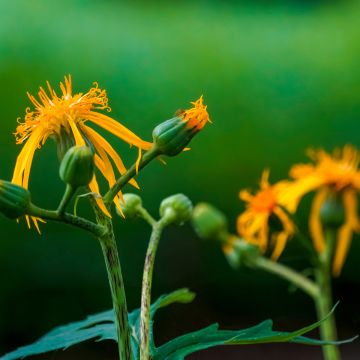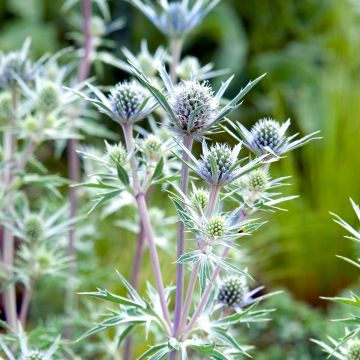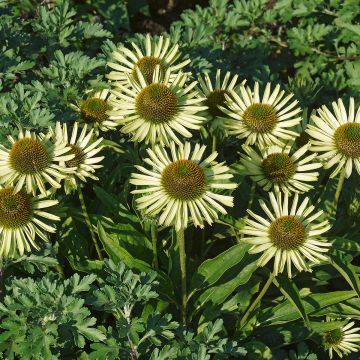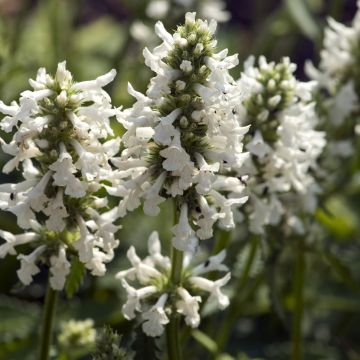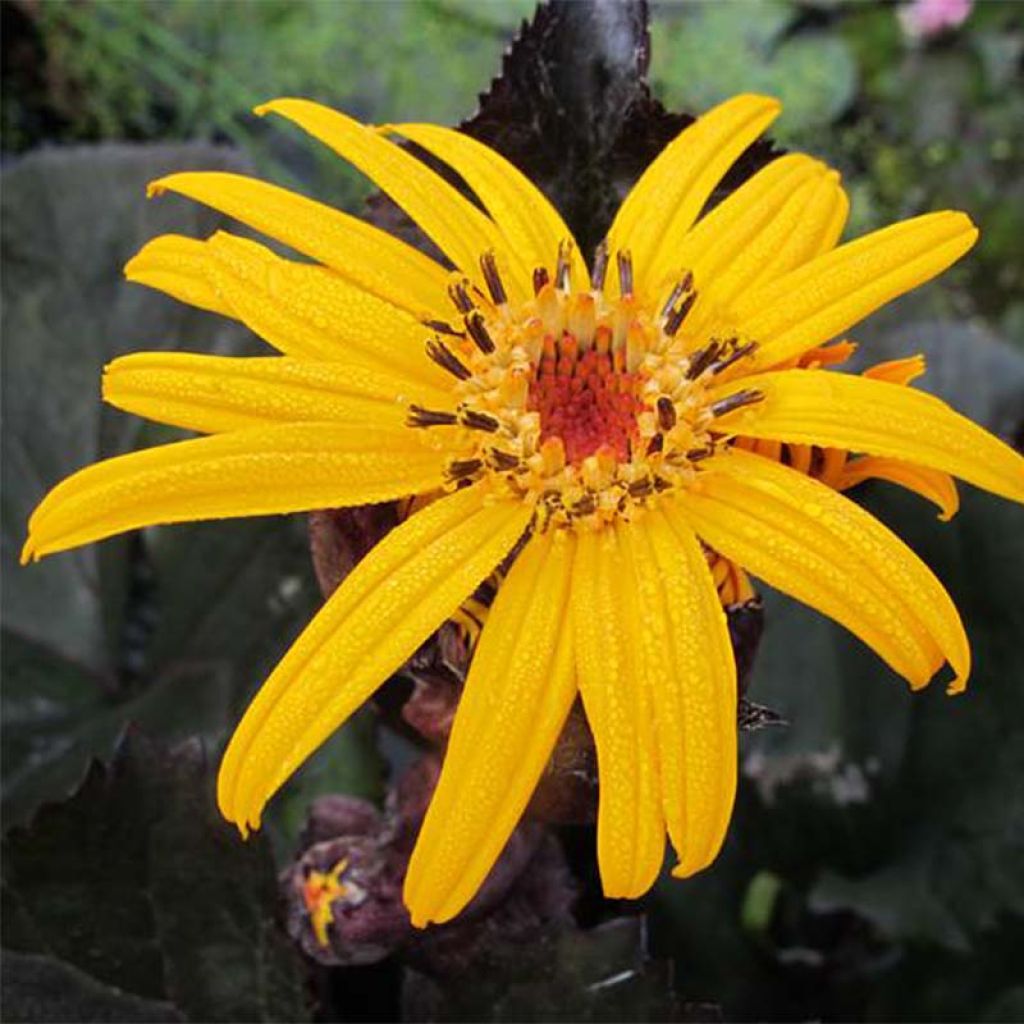

Ligularia dentata Pandora - Leopard Plant


Ligularia dentata Pandora - Leopard Plant
Ligularia dentata Pandora - Leopard Plant
Ligularia dentata Pandora®
Leopard Plant
This item cannot be shipped to the selected country
Delivery charge from €5.90
More information
Schedule delivery date,
and select date in basket
This plant carries a 12 months recovery warranty
More information
We guarantee the quality of our plants for a full growing cycle, and will replace at our expense any plant that fails to recover under normal climatic and planting conditions.
From €5.90 for pickup delivery and €6.90 for home delivery
Express home delivery from €8.90.
Does this plant fit my garden?
Set up your Plantfit profile →
Description
The Ligularia dentata 'Pandora', a true gem of wetlands, is a brand new variety of leopard plant that stands out for its small size, well suited for pot cultivation and border landscaping. As colourful as its larger sisters 'Britt Marie Crawford' or 'Desdemona', the lovely Pandora develops a small cordate, dark foliage, which perfectly highlights its bright yellow-orange flowers. Produced in the heart of summer, as if placed above its foliage, they radiate like little suns. This perennial will thrive in a garden between light shade and gentle sun, where it will never lack water.
The Ligularia dentata, sometimes called summer senecio, is native to China and Japan. The 'Pandora' variety, from which it originates, belongs, like it, to the large family of Asteraceae. This perennial forms a compact clump in spring that will not exceed 40 cm (16in) in height and 40-50 cm (16-20in) in width. Its growth is quite slow. The small leaves of this variety are carried by a long petiole. They are tough, cordate at the base and very rounded, with strongly toothed edges. The leaves are tinted with violet-black, with very dark green reflections intensifying over the season, while the reverse is strongly tinted with brick and coppery mahogany. From July to September, corymbs or bouquets of inflorescences in heads bloom, which we call flowers. Each head, 5-6 cm (2in) wide, is composed of a row of ligulate florets that are bright yellow turning to orange at the base, very bright, organized in a collar around a central disc that is more brown. It bursts at the top of tall red and branched stems, with a button of mandarin orange colour. The vegetation of the ligularia disappears in winter and develops again in spring.
Plant the 'Pandora' Dentate Ligularia in moist, rich, deep, neutral to acidic soil. This plant cannot tolerate lack of water and adapts very well to clay soils, if they are healthy and well amended. The Pandora ligularia is planted in groups of 3 to 6 specimens, for example along the edge of a pond or in very wet areas of the garden. It also grows very well in pots on the terrace, with regular watering, in filtered light. For example, associate it with hostas, Carex morrowii, loosestrifes, and willowherbs to decorate the edges of water features. It will sometimes naturalize where the soil is constantly moist, protected from the burning rays of the sun. It is a good plant for beautifying a shaded area, on the north side of the house.
Report an error about the product description
Ligularia dentata Pandora - Leopard Plant in pictures


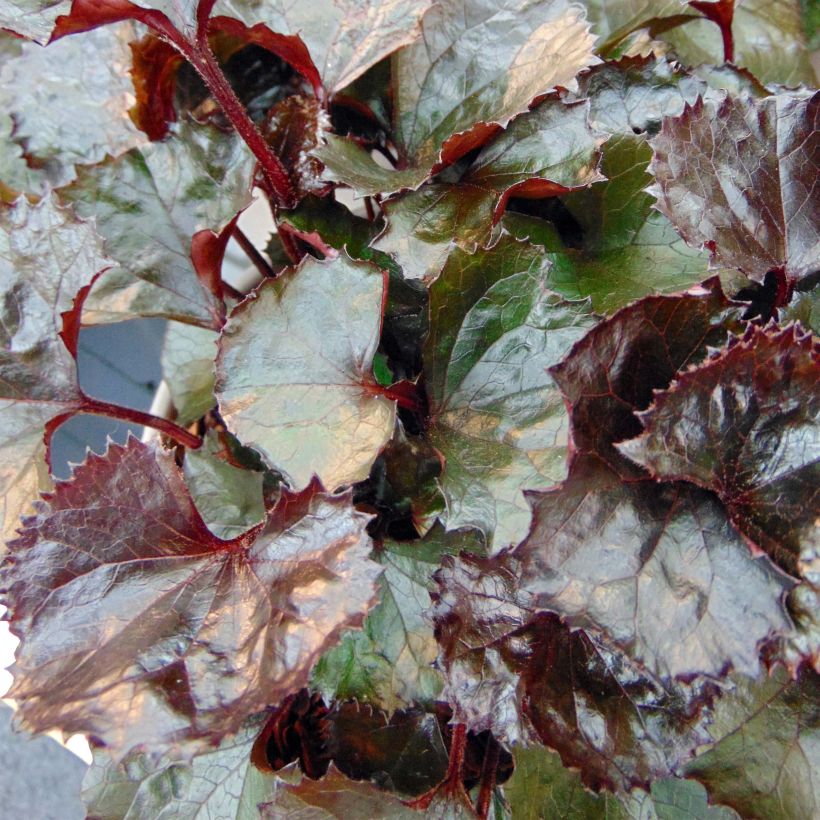

Flowering
Foliage
Plant habit
Botanical data
Ligularia
dentata
Pandora®
Asteraceae
Leopard Plant
Cultivar or hybrid
Other Ligularia
Planting and care
Plant the 'Pandora' Dentate Ligularia in moist, rich, deep, neutral to acidic soil as it fears the presence of excessive limestone in the soil. This plant cannot tolerate lack of water. It adapts well to clay soils if they are healthy and well amended. Install this ligularia in partial shade or a sunny but not scorching location and sheltered from strong winds. Adding compost at the start of the growing season will promote the growth of this hungry plant. This ligularia requires little maintenance, and a light cleaning of the clumps can be done in autumn. It will be necessary to pay particular attention to attacks by gastropods, which are frequent.
Planting period
Intended location
Care
This item has not been reviewed yet - be the first to leave a review about it.
Summer flowering perennials
Haven't found what you were looking for?
Hardiness is the lowest winter temperature a plant can endure without suffering serious damage or even dying. However, hardiness is affected by location (a sheltered area, such as a patio), protection (winter cover) and soil type (hardiness is improved by well-drained soil).

Photo Sharing Terms & Conditions
In order to encourage gardeners to interact and share their experiences, Promesse de fleurs offers various media enabling content to be uploaded onto its Site - in particular via the ‘Photo sharing’ module.
The User agrees to refrain from:
- Posting any content that is illegal, prejudicial, insulting, racist, inciteful to hatred, revisionist, contrary to public decency, that infringes on privacy or on the privacy rights of third parties, in particular the publicity rights of persons and goods, intellectual property rights, or the right to privacy.
- Submitting content on behalf of a third party;
- Impersonate the identity of a third party and/or publish any personal information about a third party;
In general, the User undertakes to refrain from any unethical behaviour.
All Content (in particular text, comments, files, images, photos, videos, creative works, etc.), which may be subject to property or intellectual property rights, image or other private rights, shall remain the property of the User, subject to the limited rights granted by the terms of the licence granted by Promesse de fleurs as stated below. Users are at liberty to publish or not to publish such Content on the Site, notably via the ‘Photo Sharing’ facility, and accept that this Content shall be made public and freely accessible, notably on the Internet.
Users further acknowledge, undertake to have ,and guarantee that they hold all necessary rights and permissions to publish such material on the Site, in particular with regard to the legislation in force pertaining to any privacy, property, intellectual property, image, or contractual rights, or rights of any other nature. By publishing such Content on the Site, Users acknowledge accepting full liability as publishers of the Content within the meaning of the law, and grant Promesse de fleurs, free of charge, an inclusive, worldwide licence for the said Content for the entire duration of its publication, including all reproduction, representation, up/downloading, displaying, performing, transmission, and storage rights.
Users also grant permission for their name to be linked to the Content and accept that this link may not always be made available.
By engaging in posting material, Users consent to their Content becoming automatically accessible on the Internet, in particular on other sites and/or blogs and/or web pages of the Promesse de fleurs site, including in particular social pages and the Promesse de fleurs catalogue.
Users may secure the removal of entrusted content free of charge by issuing a simple request via our contact form.
The flowering period indicated on our website applies to countries and regions located in USDA zone 8 (France, the United Kingdom, Ireland, the Netherlands, etc.)
It will vary according to where you live:
- In zones 9 to 10 (Italy, Spain, Greece, etc.), flowering will occur about 2 to 4 weeks earlier.
- In zones 6 to 7 (Germany, Poland, Slovenia, and lower mountainous regions), flowering will be delayed by 2 to 3 weeks.
- In zone 5 (Central Europe, Scandinavia), blooming will be delayed by 3 to 5 weeks.
In temperate climates, pruning of spring-flowering shrubs (forsythia, spireas, etc.) should be done just after flowering.
Pruning of summer-flowering shrubs (Indian Lilac, Perovskia, etc.) can be done in winter or spring.
In cold regions as well as with frost-sensitive plants, avoid pruning too early when severe frosts may still occur.
The planting period indicated on our website applies to countries and regions located in USDA zone 8 (France, United Kingdom, Ireland, Netherlands).
It will vary according to where you live:
- In Mediterranean zones (Marseille, Madrid, Milan, etc.), autumn and winter are the best planting periods.
- In continental zones (Strasbourg, Munich, Vienna, etc.), delay planting by 2 to 3 weeks in spring and bring it forward by 2 to 4 weeks in autumn.
- In mountainous regions (the Alps, Pyrenees, Carpathians, etc.), it is best to plant in late spring (May-June) or late summer (August-September).
The harvesting period indicated on our website applies to countries and regions in USDA zone 8 (France, England, Ireland, the Netherlands).
In colder areas (Scandinavia, Poland, Austria...) fruit and vegetable harvests are likely to be delayed by 3-4 weeks.
In warmer areas (Italy, Spain, Greece, etc.), harvesting will probably take place earlier, depending on weather conditions.
The sowing periods indicated on our website apply to countries and regions within USDA Zone 8 (France, UK, Ireland, Netherlands).
In colder areas (Scandinavia, Poland, Austria...), delay any outdoor sowing by 3-4 weeks, or sow under glass.
In warmer climes (Italy, Spain, Greece, etc.), bring outdoor sowing forward by a few weeks.










































